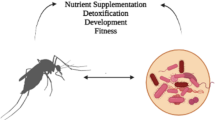Summary
In that 3rd part, the author gives indications concerning the mass breeding ofTrichogramma australicum and its replacement hostCorcyra cephalonica Staint. Said host was chosen because of the volume of its eggs and its resistance toTribolium; its larvae are fed on a mixture of Indian corn semolina and arachis.
Description is given of a model breeding cell, capable of producing 250 000 000 eggs in 6 months.
Breeding of the Trichogramme is conducted so as to enable the selection of offsprings from females that come out first (as these did not suffer from superparasitism, their size, activity and fecundity are optima). To obtain successful results in that type of breeding it is essential to have the right proportion of parasites and hosts.
Having explained the method for keeping the parasited eggs prior to shipping them to the sugar-plantations, the author then gives a few quotations on the possible output of a breeding unit.
Similar content being viewed by others
Bibliographie
Brenière, J. — 1959. Multiplication artificielle deTrichogramma australicum, parasite deProceras sacchariphagus, borer de la canne à sucre à Madagascar. — Mémoire ronéotypé ORSTOM; résumé:Bulletin du Service de Défense des Cultures de la F.O.M.
Costas, L. A. — 1951. The effect of warying conditions on oviposition byTrichogramma on eggs of Angoumois grain Moths. —J. econ. Ent.,34, 57–58.
Flanders, S. E. — 1930.a) Mass production of egg parasites of the genusTrichogramma. —Hilgardia,4, 465–501.
Flanders, S. E. — 1930b. Recent developments inTrichogramma Production. —J. econ. Ent.,23, 837–841.
— 1930c. A Suggestion for the automatic Collection ofSitotroga. —J. econ. Ent.,23, 1008.
— 1933.Sitotroga production. —J. econ. Ent.,26, 510–511.
— 1945. Mass production ofTrichogramma using eggs of Potato tuber Worm. —J. econ. Ent.,38, 394–395.
Hama, T. — 1938. On the cold storage of the eggs ofEphestia cautella Walk. andTrichogramma japonicum Ashm. (In Japanese). —Oyo. Dobuts. Zasshi,10, 111–114.
King, C. B. R. — 1934. Cold Storage Effect onTrichogramma and on the eggs ofEphestia kühniella. —Tea quart,7, 19–27, Ceylon.
Krishnamurti, B. — 1942.Trichogramma minutum Riley, in relation toSitotroga cerealella Ol. in Mysore. —Curr. Sci.,9, 554,Bangalore.
Kunhi-Kannan, K. — 1932. The mass rearing of the egg parasites of the sugarcane moth borer in Mysore. (Preliminary experiments). —J. Mysore Agric. Exptl. Un,12, 57–61, Bangalore.
Moutia, A. — 1937. Entomological Division. —Rep. Dep. Agric., Mauritius, 1936, 37–39.
Moutia, A. — 1942. Division of Entomology. —Rep. Dep. Agric., Mauritius, 1941, 14–21.
Porquez, P. H. & Tabayoyong, F. T. — 1960.Trichogramma breeding. —Victoria Milling Co, Exp. Stat. Release (Philippines) 1959 (27), 11 pp.Rep. Int. Sug. Journ. February 1960, p. 34.
Seshagiri Rao, D. — 1954. Notes on the rice mothCorcyra cephalonica (Stainton) FamilyGalleriidae, Lepidoptera. —India J. Ent. 16, 95–114.
Schread, J. C. &Garman, P. — 1934. Some effects of refrigeration on the biology ofTrichogramma in artificial breeding. —J. N. Y. ent. Soc.,42, 263–283.
Spencer, H., Brown, L. & Phillips, A. M. — 1935. New equipment for obtaining host material for the mass production ofTrichogramma minutum, an egg parasite of various Insect pests. —Circ. U. S. Dep. Agric., 376, 17.
Subramaniam, T. V. — 1937. Preliminary experiments on the mass-production ofTrichogramma parasites for control against sugarcane borers in Mysore. —Indian J. agric. Sci.,7, 149–155.
Trehan, K. N. &Rajarao, S. A. — 1945. A Note on the predatory habits ofTribolium beetles. —Curr. Sci.,14, 209–210.
Tucker, R. W. E. — 1931. Sugar Cane Borers. The mass breeding ofTrichogramma minutum to controlDiatraea saccharalis in Barbados during 1930. —Trop. Agricult.,8, 283–288.
Urquijo, P. — 1946. Seleccion de estirpes deTrichogramma minutum Riley de maxima fectividad parasitaria. —Bol. Pat. Veg. Ent. agric.,14, 199–216, Madrid.
Rights and permissions
About this article
Cite this article
Brenière, J. Les trichogrammes parasites deProceras sacchariphagus Boj. borer de la canne a sucre a Madagascar. Entomophaga 10, 119–131 (1965). https://doi.org/10.1007/BF02385287
Published:
Issue Date:
DOI: https://doi.org/10.1007/BF02385287




